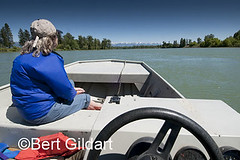Are Great Blue Herons Diminishing In Number?
©Bert Gildart: Over the years Janie and I have made many boat trips from our home near Montana’s Flathead River to fish, to evaluate the immense changes in human population that have occurred, to look for one of our favorite birds – and seek out the impressive rookeries this species has created.
In short, we’ve caught some fish, mostly pike; have agreed that the number of people establishing homes along the river is deplorable; and that for that reason the vast Great Blue Heron rookeries that once existed up and down the Flathead have greatly diminished. At least that is what we have recently suspected and was the big reason we pushed off two days ago; we wanted to find out.
Traveling up Montana’s Flathead River from our home near Bigfork, searching for Great Blue Heron Rookeries and for other story-telling features, such as this old barn.
We pointed our johnboat (one we’ve also used for months on end on the Yukon River) upstream. The wind was blowing hard and to avoid a bumpy ride we proceeded slowly, pulling back even further on the throttle as we passed the site where one man has attempted to create a huge marina despite the objection of many neighbors in this small Flathead Valley farming community.
We were among those objecting, so when we saw the owner working along the shoreline, pointing at his huge tin storage area – waving us ashore – we turned without reciprocating and traveled on. Childish, perhaps, but few wanted him here, and we most certainly agreed. He was arrogant, and we didn’t like him either.
Continuing, we passed by an old log barn that was of interest, thinking that if barns could talk this one might have quite a story.
MULTITUDE OF BIRDS
Of course we kept our eyes open for bird life. Along the way, we saw a number of ospreys, one Bald Eagle nest, and a multitude of waterfowl, such as Mallards. We even saw several Great Blue Herons, but sadly, one of the rookeries that existed several years ago had been abandoned. And so, we continued our search, powering yet further upstream.
Within the hour, we approached a piece of land that had been preserved by the Nature Conservancy, and it was here that we saw several herons rise from a collection of nests. We turned off the engine and listened.
Sitting quietly, we heard the chatting of several black birds and the distinct sound of nesting pair of Sandhill Cranes. We were encouraged, and paddled into the shore.
Great Blue Herons are known for the huge rookeries they create, when given a chance. In years gone by, I had counted three large rookeries, and, now, had found a new one. Some large rookeries can number 50 to 60 nests, but this one numbered but 19. Still it was impressive, and so as not to disturb the nesting birds, I pulled out an 800mm lens and then Janie and I settled in to watch.
LARGEST OF ALL HERONS
The Great Blue Heron is the largest of all North American herons and is well known for the loud croaking sound it makes just prior to flying. The species has been around a long, long time, having evolved during the Paleocene, or about 65 million years ago.
In addition to size, you also recognize the species by virtue of its long plume-like feathers sprouting from its lower neck. They are prized by some, and so the bird is at times shot by a certain group of unconscionable “sportsmen.”
As well as size and coveted feathers the stiletto-like bill is somewhat unique in that it changes during breeding season from a dull yellow to a somber orange. The lower parts of their legs also change at this time – going from grey to an orangey color.
As we watched the birds, every now and then the young would poke their heads above the rim of the nest, voicing their need for food. About the same time, one of the parents would fly off, returning 20 to 30 minutes later with food.
We photographed the birds for over an hour, and then returned to our boat. We powered further up the river, stopping near a place called Foy’s Bend, where we had seen a rookery just two years ago. Sadly, it was gone, and we had to assume the influx of more people along the river was the cause. That or perhaps the shooting!
I realize that growth in the valley is inevitable, but still lament the fact that we as a species are intent on destroying our planet with oil spills, unchecked population growth, and attitudes that are destructive toward virtually all species but ourselves.
On the flip side, I am delighted I can still find simple things such as a Great Blue Heron Rookery near our home, and that some species manage to conduct themselves in the same way they have done for millions of years. Though improbable, we hope change here in the Flathead will proceed at a slower rate else the very features that lured people here initially will cease to exit.
————————————————————————————–
THIS TIME LAST YEAR:
ADS FROM GOOGLE AND AMAZON AUGMENT OUR TRAVELS:






June 19th, 2010 at 7:44 am
Bert,
If you want to see an area thriving with Great Blue Herons, remind me to tell you about Burro Creek over near Nothing Arizona. I could not believe the Heron activity in that canyon and along the river. The Airstream was parked across from a cliff face above the river, and each morning I had quite the show from the birds!
Rich